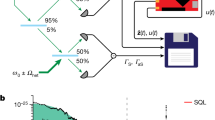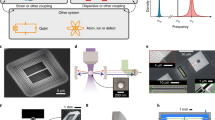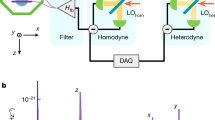Abstract
Recent advances in the fabrication of microelectromechanical systems and their evolution into nanoelectromechanical systems have enabled researchers to measure extremely small forces, masses and displacements1. In particular, researchers have developed position transducers with resolution approaching the uncertainty limit set by quantum mechanics2,3,4,5. The achievement of such resolution has implications not only for the detection of quantum behaviour in mechanical systems, but also for a variety of other precision experiments including the bounding of deviations from newtonian gravity at short distances6 and the measurement of single spins7. Here, we demonstrate the use of a quantum point contact as a sensitive displacement detector capable of sensing the low-temperature thermal motion of a nearby micromechanical cantilever. Advantages of this approach include versatility due to its off-board design, compatibility with nanoscale oscillators and, with further development, the potential to achieve quantum-limited displacement detection8,9.
This is a preview of subscription content, access via your institution
Access options
Subscribe to this journal
Receive 12 print issues and online access
$259.00 per year
only $21.58 per issue
Buy this article
- Purchase on SpringerLink
- Instant access to full article PDF
Prices may be subject to local taxes which are calculated during checkout





Similar content being viewed by others
References
Schwab, K. C. & Roukes, M. L. Putting mechanics into quantum mechanics. Phys. Today 58, 36–42 (2005).
Knobel, R. G. & Cleland, A. N. Nanometre-scale displacement sensing using a single electron transistor. Nature 424, 291–293 (2003).
Naik, A. et al. Cooling a nanomechanical resonator with quantum back-action. Nature 443, 193–196 (2006).
LaHaye, M. D. et al. Approaching the quantum limit of a nanomechanical resonator. Science 304, 74–77 (2004).
Flowers-Jacobs, N. E., Schmidt, D. R. & Lehnert, K. W. Intrinsic noise properties of atomic point contact displacement detectors. Phys. Rev. Lett. 98, 096804 (2007).
Smullin, S. J. et al. Constraints on Yukawa-type deviations from Newtonian gravity at 20 microns. Phys. Rev. D 72, 122001 (2005).
Rugar, D., Budakian, R., Mamin, H. J. & Chui, B. W. Single spin detection by magnetic resonance force microscopy. Nature 430, 329–332 (2004).
Clerk, A. A., Girvin, S. M. & Stone, A. D. Quantum-limited measurement and information in mesoscopic detectors. Phys. Rev. B 67, 165324 (2003).
Clerk, A. A. Quantum-limited position detection and amplification: A linear response perspective. Phys. Rev. B 70, 245306 (2004).
Caniard, T. et al. Ultrasensitive optical measurement of thermal and quantum noises. Opt. Spectrosc. 103, 225–230 (2007).
Arcizet, O. et al. High-sensitivity optical monitoring of a micromechanical resonator with a quantum-limited optomechanical sensor. Phys. Rev. Lett. 97, 133601 (2006).
Bleszynski-Jayich, A. C., Shanks, W. E. & Harris, J. G. E. Noise thermometry and electron thermometry of a sample-on-cantilever system below 1 Kelvin. Appl. Phys. Lett. 92, 013123 (2008).
Mamin, H. J. & Rugar, D. Sub-attonewton force detection at millikelvin temperatures. Appl. Phys. Lett. 79, 3358–3360 (2001).
Nonnenmacher, M., Vaez-Iravani, M. & Wickramasinghe, H. K. Attractive mode force microscopy using a feedback-controlled fiber interferometer. Rev. Sci. Instrum. 63, 5373–5376 (1992).
Sidles, J. A. et al. Magnetic resonance force microscopy. Rev. Mod. Phys. 67, 249–265 (1995).
van Wees, B. J. et al. Quantized conductance of point contacts in a two-dimensional electron gas. Phys. Rev. Lett. 60, 848–850 (1988).
Wharam, D. A. et al. One-dimensional transport and the quantisation of the ballistic resistance. J. Phys. C 21, L209–L214 (1988).
Field, M. et al. Measurements of Coulomb blockade with a noninvasive voltage probe. Phys. Rev. Lett. 70, 1311–1314 (1993).
Buks, E. et al. Dephasing in electron interference by a ‘which-path’ detector. Nature 391, 871–874 (1998).
Sprinzak, D., Buks, E., Heiblum, M. & Shtrikman, H. Controlled dephasing of electrons via a phase sensitive detector. Phys. Rev. Lett. 84, 5820–5823 (2000).
Cleland, A. N., Aldridge, J. S., Driscoll, D. C. & Gossard, A. C. Nanomechanical displacement sensing using a quantum point contact. Appl. Phys. Lett. 81, 1699–1701 (2002).
Li, Y. P. et al. Low-frequency noise in transport through quantum point contacts. Appl. Phys. Lett. 57, 774–776 (1990).
Stipe, B. C. et al. Noncontact friction and force fluctuations between closely spaced bodies. Phys. Rev. Lett. 87, 096801 (2001).
Stowe, T. D. et al. Attonewton force detection using ultrathin silicon cantilevers. Appl. Phys. Lett. 71, 288–290 (1997).
Wesström, J.-O. J. et al. Demonstration of quantized conductance in deeply reactive ion etched In0.53Ga0.47As/InP electron waveguides with in-plane gates. Appl. Phys. Lett. 70, 1302–1304 (1997).
Bruland, K. J. et al. Thermal tuning of a fiber-optic interferometer for maximum sensitivity. Rev. Sci. Instrum. 70, 3542–3544 (1999).
Acknowledgements
We thank A. A. Clerk for useful discussions and L. S. Moore for measuring the properties of the 2DEG used here. This work was supported by the Stanford-IBM Center for Probing the Nanoscale, an NSF NSEC, grant PHY-0425897. M.P.J. acknowledges support from an NDSEG Fellowship.
Author information
Authors and Affiliations
Contributions
M.P. conceived and planned the experiment in collaboration with M.P.J., C.L.D., D.G.-G. and D.R. M.P.J. prepared and characterized the QPC samples, which were fabricated by M.A.T. and M.P.J. M.P. carried out the experiment with the assistance of C.L.D., M.P.J. and H.J.M. M.P. analysed the data and wrote the paper. All authors discussed the results and contributed to the manuscript.
Corresponding author
Supplementary information
Supplementary Information
Supplementary Figure 1 (PDF 236 kb)
Rights and permissions
About this article
Cite this article
Poggio, M., Jura, M., Degen, C. et al. An off-board quantum point contact as a sensitive detector of cantilever motion. Nature Phys 4, 635–638 (2008). https://doi.org/10.1038/nphys992
Received:
Accepted:
Published:
Issue date:
DOI: https://doi.org/10.1038/nphys992
This article is cited by
-
A microwave scattering spectral method to detect the nanomechanical vibrations embedded in a superconducting qubit
Scientific Reports (2023)
-
Ultrasensitive nano-optomechanical force sensor operated at dilution temperatures
Nature Communications (2021)
-
Stabilization of a linear nanomechanical oscillator to its thermodynamic limit
Nature Communications (2013)
-
A macroscopic mechanical resonator driven by mesoscopic electrical back-action
Nature (2010)
-
Near-field cavity optomechanics with nanomechanical oscillators
Nature Physics (2009)



